|
|
Top
10 sights Lucca -
Must see place Lucca
1. The walls of
Lucca
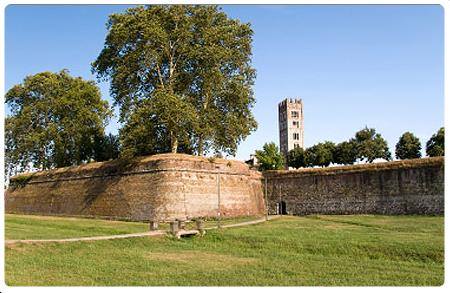 Over 4 km of walls surround Lucca, some of which are over 30
metres wide in places. It contains many underground tunnels
which have been restored and can be visited by the public.
Until the early 1990s they served as ring roads due to the
practicality of their width.
The walls of Lucca, once part of an ancient defense system,
were created when the city was a Roman colony. They were
later expanded and totally rebuilt during the Renaissance
period. Today they serve as a large city park, among the
most beautiful in the world; a raised parkland at 12 metres
in height, lined with hundreds ancient trees. Read more
about
Lucca Walls. Over 4 km of walls surround Lucca, some of which are over 30
metres wide in places. It contains many underground tunnels
which have been restored and can be visited by the public.
Until the early 1990s they served as ring roads due to the
practicality of their width.
The walls of Lucca, once part of an ancient defense system,
were created when the city was a Roman colony. They were
later expanded and totally rebuilt during the Renaissance
period. Today they serve as a large city park, among the
most beautiful in the world; a raised parkland at 12 metres
in height, lined with hundreds ancient trees. Read more
about
Lucca Walls.
The four successive and increasingly wider built walls have
defended Lucca over the centuries. Originally constructed in
the third and fourth centuries BC, in a square formation,
they
were later extended and raised. The second circle dates
from around 1200AD; the imposing Porta di San Gervasio e
Protasio (along Via dei Fossi) and the Porta Dei Borghi (or
Santa Maria) at the end of Via Fillungo, can still be seen
to this day. These large gateways, flanked by high towers,
give us an insight into the defensive structure of the city
in the past.
III circle
The third circle of walls, built between 1400 and 1500, saw
expansions and reinforcements, with the addition of towers.
The last and current fourth circle of walls was built after
1500AD. This structure incorporates the third circle and
reflects the the Lucchese government’s priority to protect
the city after the advent of gunpowder, and the spread of
firearms. The work lasted more than 100 years and was
completed in 1650; its construction witnessed some of the
finest construction techniques and as overseen by some of
the most and well known architects in the field of military
architecture.
The walls were fortunate enough to never witness a siege or
actual attack. The only threat came when the Serchio River
broke its banks in 1812, leading to disastrous flooding
during which the walls took the brunt of the force.
Today, the circle of walls extends over 4 kilometers, is 30
metres wide and 12 metres high. It is completely intact and
one of the best preserved in Europe. It consists of 11
ramparts (bulwarks), 12 curtain walls, 6 gateways and a
pedestrian promenade; shaded by trees planted in two rows at
the behest of Marie Louise of Bourbon in 1800. It was the
latter who took the decision to transform the walls into a
city park. The wall tunnels are particularly beautiful and
since their conversion into galleries, shops, warehouses and
wells, are well worth a visit.
Fortunately, unlike in other cities, the walls survived the
unification of Italy and today are a true urban icon,
preserved by the Town Council for the identity and history
of the city. Nowadays, cyclists, joggers, skaters, as well
as families, tourists and walkers can been found enjoying
these surroundings.
Palazzo Mansi
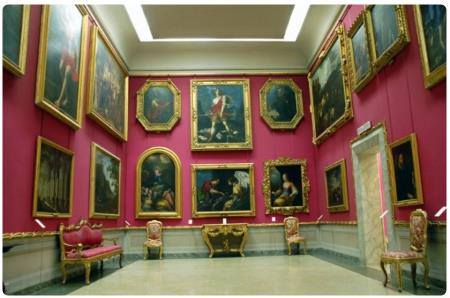 Mansi Palace is one of the most luxurious villas in Lucca
and was built between the end of 1500s and the beginning of
the 1600s. Purchased by the State in 1965, it was opened to
the public as a Museum in 1977 and transformed into a
national art gallery, with works from the Medici collections
and other locations. The main floor features richly
decorated rooms, with furniture from the 17th and 18th
centuries and Flemish tapestries. On the ground floor you
will find the temporary exhibitions, whilst on the second
floor there is an exhibition of paintings and objects
relating to the Lucchese textile industry, which for
centuries served as the driving force for the local economy. Mansi Palace is one of the most luxurious villas in Lucca
and was built between the end of 1500s and the beginning of
the 1600s. Purchased by the State in 1965, it was opened to
the public as a Museum in 1977 and transformed into a
national art gallery, with works from the Medici collections
and other locations. The main floor features richly
decorated rooms, with furniture from the 17th and 18th
centuries and Flemish tapestries. On the ground floor you
will find the temporary exhibitions, whilst on the second
floor there is an exhibition of paintings and objects
relating to the Lucchese textile industry, which for
centuries served as the driving force for the local economy.
Much of the collection consists of 83 works donated to the
town in 1847 by Grand Duke Peter Leopold II, after the
annexation of Lucca to the Grand Duchy of Tuscany. These
works were donated to the city with the intent of enriching
the decline in local artistic heritage, following the
disastrous sale of the city’s palatine works by Carlo
Ludovico di Borbone. Another section of the museum exibits
part of the Mansi collection. Among the many paintings, two
of the most important are the sixteenth-century works:
Pontormo's Ritratto di Giovinetto (Portrait of a Youth) and
La Continenza di Scipione (The Continence of Scipio),
published in 1525 by Beccafumi. Also on exhibit are works by
artists such as Titian, Tintoretto, Veronese, Guido Reni,
Ghirlandaio, Andrea del Sarto, Vasari and Bronzino. Also
evident are works by excellent Tuscan artists from the 1750s
to the late 1800s such as: Pompeo Batoni, Cenami, Nocchi,
Tofanelli, Ridolfi, De Servi and Marcucci. Highly
recommended is Batoni, a painter well known throughout
Europe at the behest of Kings and princes; particularly his
"portrait of Archbishop Gian Domenico Mansi" of 1765 (he was
one of the contributors to the Lucchese Encyclopedia of
Diderot and Alembert). Also of note is a curious Mansi
family tree on display, dating from the second half of the
1700s. Rooms to visit are the "
Sala dell'Aria" from the end
of the 1600s and "Sala della Musica" from the same period.
Here you will also find a beautiful portrait of Puccini's
1903 opera by Luigi de Servi. The Museum’s address is via
Galli Tassi 43.
Church of San
Michele in Foro
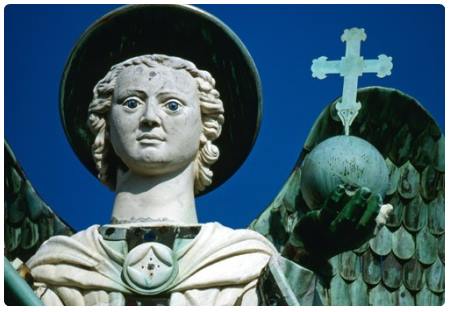 The
Church of San Michele in Foro is located on the ancient
site of a Roman Forum (hence its name), built upon a stone
foundation, with columns reaching skywards. Arriving from
any direction towards the centre, the church serves as a
striking image. The lower part of the Romanesque façade is
accompanied by a higher section built in a Gothic style.
There are four tiers of loggias which are surmounted by a
large marble statue of the Archangel Michael; he is in the
Act of defeat, a spear in hand and a dragon at his feet,
flanked by two musical angels. Such a sculpture is unique
among churches: at 4 metres in height, the statue dominates
the entire square, holding a spear in his right hand and a
crucified globe in his left. According to local legend, a
strange shimmer can sometimes be seen emerging from the
precious stone of the angel's ring. The
Church of San Michele in Foro is located on the ancient
site of a Roman Forum (hence its name), built upon a stone
foundation, with columns reaching skywards. Arriving from
any direction towards the centre, the church serves as a
striking image. The lower part of the Romanesque façade is
accompanied by a higher section built in a Gothic style.
There are four tiers of loggias which are surmounted by a
large marble statue of the Archangel Michael; he is in the
Act of defeat, a spear in hand and a dragon at his feet,
flanked by two musical angels. Such a sculpture is unique
among churches: at 4 metres in height, the statue dominates
the entire square, holding a spear in his right hand and a
crucified globe in his left. According to local legend, a
strange shimmer can sometimes be seen emerging from the
precious stone of the angel's ring.
The origins of the Church are ancient and date back to a
period prior to 795, the year of the first documentation.
The current structure is more recent, however. Pope
Alexander II rebuilt the church in late eleventh century.
The building’s construction building was staggered over many
centuries, hence the ensuing architectural style seen today,
is the result of many periods from Romanesque to Gothic.
Today, the church seems like a timeless structure, almost
like a modal placed there by some kind of divine presence.
The latest structure built by Alexander II was a
collaboration of several architects who now form part of
Lucca’s history. The façade is the work of a Lombardese
architect, responsible particularly for the entrance door
with lintels ornately carved with motifs. The Lunette above
the main door of the Church is decorated with the depiction
of a wheel of fortune, flanked by a pair of lions. Under the
bezel are reliefs representing a mermaid with two tails (the
symbol of duplicity and deceit) and a Centaur (symbol of
violence and brutality). Between the two you can see St.
Michael slaying the Dragon. Among the figures decorating the
arches on the façade, (the latter renovated and modified
several times), are some of the key characters of the
Italian Risorgimento, which served to replace some of the
damaged figures (Cavour and Giuseppe Garibaldi, Vittorio
Emanuele II, just to name a few).
What will you discover inside the Church?
The interior of the Church of San Michele in Foro has a
Latin cross-shaped plan and houses many important works of
art. Most famous is the Madonna col Bambino (Madonna and
Child) by Matteo Civitali, which can be seen on the wall to
the right as you enter. Another beautiful depiction of the
Madonna by Andrea della Robbia can also be seen on a glazed
earthenware artifact. It can be found on the first altar to
the right. Another significant piece is the so-called Pala
Magrini (it is unmissable due to its bright colours, found
on the wall to the right of the transept), a masterpiece
painted by Filippino Lippi, with depictions of the Saints
Rocco and Sebastiano, Girolamo and Elena. The latter
painting is typical of many from this period, showing the
face of the Saint recalling the melancholy of idealisation,
similar to that of Primavera by
Botticelli. Significantly,
at the time, Filippino Lippi was active in the Botticelli
workshop in Florence. One last important work within the
Church is the high relief of the Virgin sculpted by
Raffaello da Montelupo, once a close associate of
Michelangelo.
Three generations of Puccini have played the organ in this
church, including the young Giacomo, who lived only 50
meters away, and who as a boy sang in the church choir. As
you leave the church, turn left and in the centre of the
square, you will see the statue of Francesco Burlamacchi, a
Lucchese gonfaloniere, beheaded in 1548 in Milan for having
plotted against Cosimo de' Medici, the latter fearing a
federal Tuscan republic ruled from Lucca.
+++
Curiosities
Now time for a pit-stop and a little surprise. As you come
out of the gate and turn right past the church, you'll find
two bars. We recommend stopping off at second, il Caffè del
Mercato, which offers excellent and well-priced snacks and
both inside and outside tables with views of the Church.
Take a breather, and as you watch the world go by, take a
look at the statue on your left, the one that lies below San
Michele at Palazzo del Vescovo. The Angel is half white and
half black. Continue walking, as you follow the church
around you’ll see the imposing apse (the apse is the back
end of a round-shaped Church).
Look at the square with your back to the church.
You’ll see the large, vivid painting by Filippino Lippi, la
Pala Magrini, with Saints Rocco, Sebastiano, Girolamo and
Elena.
Via Fillungo and
Piazza Anfiteatro
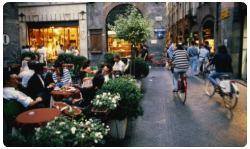 We have already spoken of Via Fillungo, a highly recommend
rout for a first impressions of the city and its ancient
commercial way of life. From Piazza San Michele, we continue
through Via Roma, in the direction of Via Fillungo. At the
corner of Via Roma and Via Cenami, you will find an entrance
to a large bookstore on your left, (once an old bank). Upon
entering you will be surprised by the vast space, the height
of the ceiling and the light coming from the multi-coloured
windows. Today the building is hom We have already spoken of Via Fillungo, a highly recommend
rout for a first impressions of the city and its ancient
commercial way of life. From Piazza San Michele, we continue
through Via Roma, in the direction of Via Fillungo. At the
corner of Via Roma and Via Cenami, you will find an entrance
to a large bookstore on your left, (once an old bank). Upon
entering you will be surprised by the vast space, the height
of the ceiling and the light coming from the multi-coloured
windows. Today the building is hom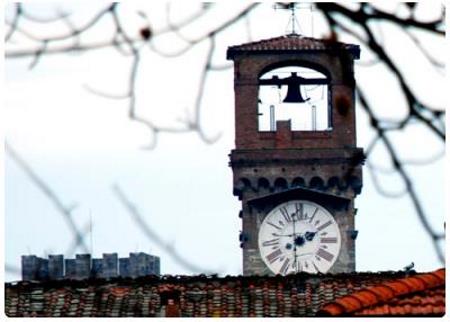 e to a plethora of books to suit
all tastes, as well as a pleasant bar where you can order
some of the finest hot chocolate in town. e to a plethora of books to suit
all tastes, as well as a pleasant bar where you can order
some of the finest hot chocolate in town.
Returning to Via
Roma, we now head to Via Fillungo. This 700 metre long road
is the so-called "parlour" of the city. Along the way you’ll
discover the beautiful Church of San Cristoforo on the
right, dating from the 12th century (deconsecrated and now
used for exhibitions and events). Soon afterwards, on the
right, is the thirteenth century civic Clock Tower.
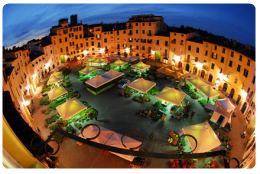 Further
on, you’ll notice an arch on your right; this is the
entrance to Piazza dell'Anfiteatro. The great arch opens
directly into the large elliptical arena of the square,
surrounded by cafés and shops. The name comes from its
location: in the 1st century AD a large Roman Amphitheatre
occupied this spot. In the middle ages, a number of
buildings were built over the remains of the previous
structure, which nevertheless stuck to the original outline.
The Amphitheatre was destroyed during the barbarian
invasions and was used as a quarry for raw materials, needed
for the construction of churches and buildings. The floor
level of the original Amphitheater is located approximately
3 metres below the current pavement. Along the outer
perimeter of the square, you can still see the remains of
massive tufa stones and boulders from the Amphitheatre. With
its size and location outside of the city walls, the
building gradually went into decline. It eventually became a
liability to the city’s security from aggressors who would
potentially use it as a base for attacks. From around the
6th century AD, the Amphitheater was fortified for military
purposes and its external arches closed. Further
on, you’ll notice an arch on your right; this is the
entrance to Piazza dell'Anfiteatro. The great arch opens
directly into the large elliptical arena of the square,
surrounded by cafés and shops. The name comes from its
location: in the 1st century AD a large Roman Amphitheatre
occupied this spot. In the middle ages, a number of
buildings were built over the remains of the previous
structure, which nevertheless stuck to the original outline.
The Amphitheatre was destroyed during the barbarian
invasions and was used as a quarry for raw materials, needed
for the construction of churches and buildings. The floor
level of the original Amphitheater is located approximately
3 metres below the current pavement. Along the outer
perimeter of the square, you can still see the remains of
massive tufa stones and boulders from the Amphitheatre. With
its size and location outside of the city walls, the
building gradually went into decline. It eventually became a
liability to the city’s security from aggressors who would
potentially use it as a base for attacks. From around the
6th century AD, the Amphitheater was fortified for military
purposes and its external arches closed.
During the Middle Ages this space became a square and was
called "
parlascio", a corruption of the Latin word "paralisium",
Amphitheatre in Latin. As the structure eventually went into
dilapidation, houses were built on the site, which gradually
became a mill, a salt depot, a jail known as "
carcere delle
grotte" (prison of caves), as well as stores and eateries.
The centre of the square was divided into sections and for a
while was used to grow vegetables. The outline of the old
complex, built above the Amphitheatre, was still visible in
1800, when the Duke, Ludovico di Borbone, commissioned
architect Lorenzo Nottolini to redevelop this urban space.
Today the Piazza dell'Anfiteatro is one of the symbols of
Lucca; its distinctive elliptical shape and characteristic
medieval building perimeter are visible on any map. The
ground floor buildings are occupied by bars, restaurants and
shops.
+++
Curiosities
The Amphitheatre’s twin. The Amphitheatre in Lucca has a
twin in Venafro in the Molise region. Venafro, at the time
of Augustus, was powerful, one of the most important cities
in the Empire. Its Amphitheatre, similarly to that of Lucca,
dates back to the first century BC and was able to
accommodate over 20000 spectators. It became, over time, a
square with houses built around its perimeter. Yet it was
not as lucky to be as well preserved as Lucca’s. Thus, there
are only two squares like this in Italy…and we know which
one we prefer!
Church of San Frediano
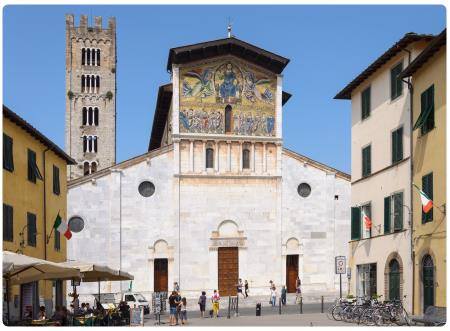 The Romanesque church of San Frediano is one of the largest
and most beautiful churches in Lucca and is noted for the
beautiful mosaic of its façade. It was built in the 12th
century on the foundations of a previous 6th-century
basilica by the Bishop Of Lucca, San Frediano, to whom the
miracle of the Serchio River is attributed. According to
legend, the Bishop was able to divert the course of the
River, which often flooded the town, with a simple gesture.
It is said that Frediano, by tracing a furrow in soil with a
rake, directed the waters to the paths he wanted them to
take. It was either the work of the divine, or the Saint’s
knowledge of hydraulics, we may never know. However, it is
documented that Frediano applied his knowledge in the
neighbouring town of Migliarino in 575. The Romanesque church of San Frediano is one of the largest
and most beautiful churches in Lucca and is noted for the
beautiful mosaic of its façade. It was built in the 12th
century on the foundations of a previous 6th-century
basilica by the Bishop Of Lucca, San Frediano, to whom the
miracle of the Serchio River is attributed. According to
legend, the Bishop was able to divert the course of the
River, which often flooded the town, with a simple gesture.
It is said that Frediano, by tracing a furrow in soil with a
rake, directed the waters to the paths he wanted them to
take. It was either the work of the divine, or the Saint’s
knowledge of hydraulics, we may never know. However, it is
documented that Frediano applied his knowledge in the
neighbouring town of Migliarino in 575.
The Byzantine mosaics of its façade were designed by artists
from the workshop of Berlinghiero Berlinghieri. The piece is
striking for the array of colours and light emitting from
the design. The work depicts the Ascension of Christ with
Angels carrying the throne upwards, and the twelve apostles
watching the scene from below. The small Piazza San Frediano,
facing the Church, offers a good view of the tower. The
latter is peculiar given the growing number of windows on
each level; at the bottom there is a single opening, but
higher up there are four. The battlement style is a typical
Ghibelline dovetail (other than the so-called "Guelph", the
top of which is square).
The interior is divided by columns imported from classical
ruins in Rome (as often happened in those days), while the
capitals originate from Lucca’s ancient Roman Amphitheatre.
The twelfth century Romanesque baptismal font is
particularly charming, finely carved in stone. The source,
lost and then shattered during the nineteeth century, was
rebuilt in the middle of last century thanks to existing
drawings. In a chapel nearby, lies the tomb of Saint Zita
(1278), whose mummified body remained untouched, and is
still visible through the transparent casket. Zita was a
devout Lucchese Christian and several miracles have been
attributed to her. Now she is the protector of households,
housewives and bakers. Behind the baptismal font at the top
of the wall, there is a glazed terracotta Lunette attributed
to Andrea della Robbia (depicting the Annunciation), and a
polychrome of the Madonna Annunciata by Matteo Civitali,
carved in the fifteetnth century. Equally, "
La Madonna col
Bambino e i Santi Lorenzo, Girolamo e Frediano", 1422, by
Jacopo della Quercia is very beautiful, as well as
sculptures, paintings and pieces of furniture from the 1500s
and1600s. Of particular note is the Renaissance organ. In
the chapel of St. Augustine, two paintings which tell the
history and legends of Lucca, are "
La deviazione del fiume
Serchio (The Deviation of the Serchio River) and the "
Storia
del Volto Santo, il trasporto a Lucca" (History of the Holy
Face, Transportation to Lucca", both from the early 1500s.
At the back of the Church, the former convent of San
Frediano was transformed into a bording school in 1809 by
Baciocchi. As you enter the college, you are led to a
cloister from the 1600s and then to another of an earlier
period. Today, the complex is called the Real Collegio and
various events are held here, especially in December when
the cloisters host an exhibit of local foods and wine called
"
Il Desco".
Pfanner Palace
and the monumental garden
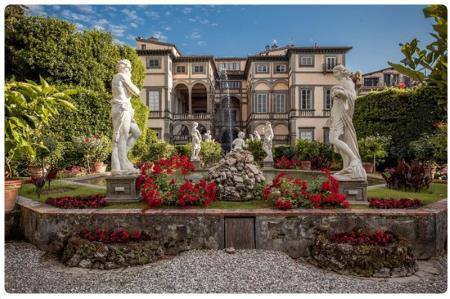 Take a walk along the walls of Lucca and you will notice the
beautiful garden of Palazzo Pfanner, one of the oldest
buildings in the city, impressive and elegant. The building,
located in Via degli Asili 33, once belonged to the Moriconi
family, a powerful local merchant family, active in the
field of silk. The building dates from the second half of
the 17th century and, by the end of that century, it changed
hands to the Controni family before being bought, in the
19th century, by Felice Pfanner, an Austrian entrepreneur,
who transformed it into a brewery. The brewery remained in
operation until 1929. In the 1990s the Pfanner family, who
still own the property, decided to open the Palace and
gardens to the public. Take a walk along the walls of Lucca and you will notice the
beautiful garden of Palazzo Pfanner, one of the oldest
buildings in the city, impressive and elegant. The building,
located in Via degli Asili 33, once belonged to the Moriconi
family, a powerful local merchant family, active in the
field of silk. The building dates from the second half of
the 17th century and, by the end of that century, it changed
hands to the Controni family before being bought, in the
19th century, by Felice Pfanner, an Austrian entrepreneur,
who transformed it into a brewery. The brewery remained in
operation until 1929. In the 1990s the Pfanner family, who
still own the property, decided to open the Palace and
gardens to the public.
The highlight of the whole complex is the Italian garden,
which is characterised by the presence of several statues
and fountains. Here you’ll find an impressive array of
magnolias, pines and fruit trees. A beautiful lemon House (see
picture) is bordered by walls on the outside. The garden was
most probably created during the 18th century by Filippo
Juvarra, one of the greatest Baroque 18th century architects
(architect of the Basilica di Superga in Turin and the
Escorial in Madrid).
+++
Curiosities
The Palace has been used as a film set several times,
including "
Il Marchese del Grillo", with the great Alberto
Sordi and "
Portrait of a Lady" with Nicole Kidman. As you
descend the walls and head back into town, turn right onto
Via Battisti, lined with beautiful palaces. This is an area
little traveled by tourists, but very impressive. The Liceo
Classico Macchiavelli is housed in a beautiful building on
this road.
Piazza Napoleone
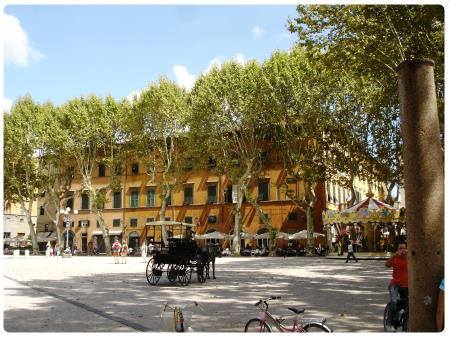 Around
Piazza Napoleone, there are a number of key
attractions, all within a short distance of each other. This
is the largest square in the city, decorated with tall plane
trees, surrounded by interesting buildings, including the
Palazzo Ducale, built in the 16th century under the
direction of the Florentine architect Bartolomeo Ammannati. Around
Piazza Napoleone, there are a number of key
attractions, all within a short distance of each other. This
is the largest square in the city, decorated with tall plane
trees, surrounded by interesting buildings, including the
Palazzo Ducale, built in the 16th century under the
direction of the Florentine architect Bartolomeo Ammannati.
The square is situated where Castruccio Castracani’s
Augsburg Fortress once stood, destroyed in the 14th century,
and later the Citadel of Lucca, which was also demolished in
the 15th century. The current structure was built in 1806 by
the order of Elisa Baciocchi Bonaparte, Napoleon's sister (from
which the square takes its name) and is the work of
architects John Laird and Pierre-Theodore Bienimé. The
Princess razed public and private buildings for four blocks
to create the space needed for the square in front of her
residence. A few years later she planted plane trees to
create shade on three sides, still present in the square
today.
On all sides of the Piazza Napoleone, aside from the Palazzo
Ducale, there are shops, bars and restaurants, some with
historical significance. These include l'Hotel Universo,
dating from the mid-1800s and frequented by artists and
learned alike, from John Ruskin to Puccini to Chet Baker.
Also the Stella Polare bar, a meeting place for the city’s
inhabitants. For the little ones, the square often hosts an
antique carousel. The roads are closed to traffic, creating
a safe space (except for some public taxi and car services).
Besides its status as the locals’ favourite hangout, Piazza
Grande is also the host for important events such as the
Lucca Summer Festival, held in July, a festival of pop music
and rock with many Italian and international stars
performing on stage.
From this square, one itinerary of interest takes you to
Palazzo Ducale, Piazza del Giglio and Piazza San Giovanni
and then to the Cathedral of San Martino. After climbing the
Walls in the garden behind the Cathedral, you continue to
the next stop, San Regolo and then visit the Botanical
Garden. As you exit, turn right, walk along Via dei Fossi
and visit Piazza San Francesco along with its church and
cloister, until you end up at the National Museum of Palazzo
Guinigi. As you will see on the map, these locations (marked
with a heart) are all very near each other.
The ‘follow your heart’ route: 8 Palazzo Ducale, 13 Teatro
del Giglio, 16 Chiesa SS Giovanni e Reparata, 17 Duomo San
Martino, then climb the walls and descend near il Baluardo
San Regolo, 33 Orto Botanico, via del Fosso, 34 Complesso
San Francesco, 35 Museo Villa Guinigi
Palazzo Ducale
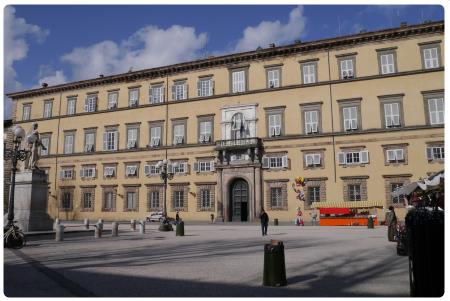 Lucca’s Palazzo Ducale is one of the main historical
buildings of the city. Also known as Palazzo della Signoria
or provincial Palace, it was built on the foundations of
Augusta, an ancient 14th century palace built by Castruccio
Castracani. The present building which dates from the 16th
century is large and was completely rebuilt under the
direction of the Florentine architect Bartolomeo Ammannati
in 1578. It was subsequently remodeled in the 18th century
by Francesco Pini in a Baroque style. Lucca’s Palazzo Ducale is one of the main historical
buildings of the city. Also known as Palazzo della Signoria
or provincial Palace, it was built on the foundations of
Augusta, an ancient 14th century palace built by Castruccio
Castracani. The present building which dates from the 16th
century is large and was completely rebuilt under the
direction of the Florentine architect Bartolomeo Ammannati
in 1578. It was subsequently remodeled in the 18th century
by Francesco Pini in a Baroque style.
As Napoleon expanded his empire, his sister, Elisa
Bonaparte, came to Lucca with her husband. With the arrival
of Felice Baciocchi and Elisa in 1805, there arose the need
to adapt the building to the needs of the new Court. The
building of the ancient Republic was austere and somewhat
bare, and needed a makeover to represent the power of the
Princes and their imperial rank. Lacking an outdoor space,
in 1806 Piazza Napoleone was built to fit alongside the
building. Local factories produced neoclassical furnishings
to create a refined Lucchese decor. Contrary to popular
belief, Elisa and her husband barely lived in the Palace,
preferring to stay in the Villa di Marlia and later, when
they became the Grand Dukes of Tuscany, at the Pitti Palace
in Florence.
Maria Luisa di Borbone, former Queen of Etruria, arrived in
Lucca in 1817 with the desire to erase every trace of rival
Elisa, who had taken the throne of Tuscany. After the
Congress of Vienna, Lucca became a Duchy, and the new
Duchess, as opposed to Elisa, chose the Palace as her
residence and remained there for some time. Lorenzo
Nottolini was appointed court architect, helping to renew
the image of the building, changing the interiors. Elisa had
removed all furniture and objects; therefore Maria Luisa had
to redecorate all rooms. Its precious tapestries and
furniture disappeared in 1847 when her son, Carlo Ludovico
di Borbone, fled Lucca in disgrace. With the death of the
Duchess, in 1824, the Lucchese Ducale was one of the richest
holds in Italy.
These original interiors, which can still be seen today,
include the big staircase, known as "
Scalone Nottolini", the
Gallery of statues (at the top of the stairs), the Hall of
the General Council, the Loggia by Ammannati (in the
courtyard called "Swiss" for the presence of Switzerland in
the Republic Guard barracks) and the Hall of Staffieri.
With the unification of Italy, the Palace became an asset of
the Crown. The King, Vittorio Emanuele II, was not
interested in keeping it and removed all valuable furniture;
the building grew to accommodate the province initially and
then became public offices. More recently, awareness of the
artistic value of the building has led to some of the luxury
apartments being opened to the public and it can now be used
for exhibitions, conventions and public occasions.
Santi Giovanni e
Reparata
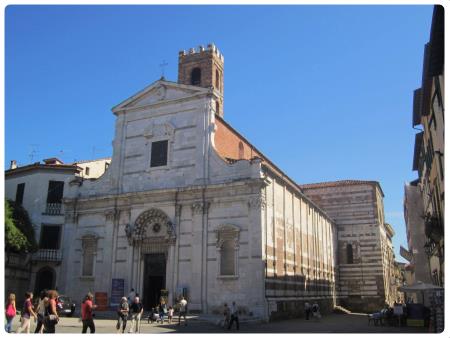 The complex, which consists of the small square of San
Giovanni, the baptistery and the Church of San Giovanni and
Santa Reparata, has its origins in the 5th century. The
foundations of the Church were built over an ancient
settlement of buildings and Roman baths. The current
structure dating from the 12th century hides a much older
origin: it is located on top of a church of Lombard origin,
which until the 8th century served as the city's Cathedral
which was in turn built on top of a paleo-Christian Church
cemetery dating from the 5th century and 6th century. The
baptistery and the Church were originally different
buildings, joined by the Episcopal Church's role in both.
The function of Cathedral was passed to the nearby church of
San Martino from the 8th century. The complex, which consists of the small square of San
Giovanni, the baptistery and the Church of San Giovanni and
Santa Reparata, has its origins in the 5th century. The
foundations of the Church were built over an ancient
settlement of buildings and Roman baths. The current
structure dating from the 12th century hides a much older
origin: it is located on top of a church of Lombard origin,
which until the 8th century served as the city's Cathedral
which was in turn built on top of a paleo-Christian Church
cemetery dating from the 5th century and 6th century. The
baptistery and the Church were originally different
buildings, joined by the Episcopal Church's role in both.
The function of Cathedral was passed to the nearby church of
San Martino from the 8th century.
The current church is made up of three central naves,
supported by columns and capitals characterised by beautiful
interior decorations, the baptismal font and the chapel
dedicated to Saint Ignatius. The latter, built by Domenico
Martinelli, is one of Lucca’s most interesting Baroque
achievements and is completely covered in polychrome. The
frescoes on its dome are attributed to Ippolito Marracci and
depict the glory of Saint Ignatius. The dome of the Church
is very unique, divided into eight parts and surmounted by a
lantern dating back to 1393. The stained glass windows are
fine works of art from the 1500s. Restoration work began in
1968 and lasted 25 years. During this time several ancient
artifacts, as well as the original layout of the fifth
century Basilica were unearthed, including an early
Christian baptistery. The excavations under the baptistery
have unearthed layers corresponding to different periods of
Lucca’s history, from its foundations until the late Roman
Empire, when the area gained its first cathedral. Among the
oldest finds are: remnants of the paving from a Roman Domus
( 1st century BC), baths from the 1st-2nd century AD, the
Lombard burials, as well as evidence of an early medieval
Baptistery and Carolingian crypt. The archaeological
excavations can be visited through guided tours.
+++
Curiosities
Puccini's music today. From March to October, the church
hosts daily concerts at 19:00 devoted to Puccini. Puccini
was baptized here on 23 December 1858. In winter, concerts
entitled "Puccini e la sua Lucca" (Puccini and his Lucca)
are held a short distance away, in the Oratory of San
Giuseppe at the Cathedral Museum.
Lucca’s
Cathedral
 Arriving in Piazza San Martino, the eye is immediately drawn
to the striking Cathedral, one of the oldest and most
interesting churches in Tuscany. The façade as you see it
today was designed in the 12th century and is the oldest
part of the Romanesque Church. The entrance to the Church
lies under a porch with three arches, surmounted by a series
of loggias with small, "
ofitiche" columns, that is knotted
together. Besides the statue of San Martino, another figure
can also be seen on the façade; he holds a scroll in his
hand dated 1204 and enscripted "
to Guidetto from Como". This
was the architect responsible for the design of the
Cathedral. Arriving in Piazza San Martino, the eye is immediately drawn
to the striking Cathedral, one of the oldest and most
interesting churches in Tuscany. The façade as you see it
today was designed in the 12th century and is the oldest
part of the Romanesque Church. The entrance to the Church
lies under a porch with three arches, surmounted by a series
of loggias with small, "
ofitiche" columns, that is knotted
together. Besides the statue of San Martino, another figure
can also be seen on the façade; he holds a scroll in his
hand dated 1204 and enscripted "
to Guidetto from Como". This
was the architect responsible for the design of the
Cathedral.
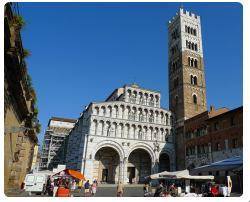 Like the façade of the Church of San Michele in Foro, the
Cathedral has some unusual features. First of all, it is
highly skewed, and this is strange for the churches, which
are usually symmetrical so to achieve divine perfection. Of
the three arches, the one on the right is much narrower than
the other two. Under the narrowest arch, lies a curious tile
with the image of a labyrinth inlaid. The inscription
roughly says: "This is the Cretan labyrinth built by
Daedalus from which no one who entered it could exit, except
Theseus aided by Ariadne's thread". The labyrinth is a
mysterious image, but it should be remembered that Lucca was
at the centre of the
Via Francigena, the road traveled by
pilgrims on their way to Rome, also named "via dei
labirinti" (labyrinth road). The maze appeals to lovers of
symbolism and may be subject to numerous interpretations.
The image of the maze shows an intricate and difficult
pathway; reinterpreted in the Christian sense it becomes the
allegory of the perilous route that man faces to reach the
salvation of the soul. Some may perceive the similarity
between the labyrinth of Chartres Cathedral in France with
that of Lucca, as well as the maze of Alatri in the
Frosinone province. Like the façade of the Church of San Michele in Foro, the
Cathedral has some unusual features. First of all, it is
highly skewed, and this is strange for the churches, which
are usually symmetrical so to achieve divine perfection. Of
the three arches, the one on the right is much narrower than
the other two. Under the narrowest arch, lies a curious tile
with the image of a labyrinth inlaid. The inscription
roughly says: "This is the Cretan labyrinth built by
Daedalus from which no one who entered it could exit, except
Theseus aided by Ariadne's thread". The labyrinth is a
mysterious image, but it should be remembered that Lucca was
at the centre of the
Via Francigena, the road traveled by
pilgrims on their way to Rome, also named "via dei
labirinti" (labyrinth road). The maze appeals to lovers of
symbolism and may be subject to numerous interpretations.
The image of the maze shows an intricate and difficult
pathway; reinterpreted in the Christian sense it becomes the
allegory of the perilous route that man faces to reach the
salvation of the soul. Some may perceive the similarity
between the labyrinth of Chartres Cathedral in France with
that of Lucca, as well as the maze of Alatri in the
Frosinone province.
The whole façade is richly decorated and carved with
lunettes above the three gateways, depicting the "Martyrdom
of St Regulus" (right), the "Deposition" by Nicola Pisano (left)
and the "Ascension of Christ" in the Central bezel. On the
right side of the façade is the statue of Martin on
horseback, in the act of sharing his precious cloak with the
poor.
To the side of the Cathedral, you will find Piazza
Antelminelli, enclosed by wall of the Palazzo Micheletti
garden, with giant magnolia that grows beyond its perimeters.
In the middle of the square you will find a beautiful
neoclassical fountain designed by Lorenzo Nottolini in 1832,
an excellent example of the addition of a new decorative
element in a pre-existing context.
Now we enter the church…
Once inside the Cathedral, one is struck by the expanse of
space as the eye is drawn upwards. This church is impressive;
84 metres in length and width and a height of almost 30
metres. The Latin cross plan is divided into three naves.
The Gothic atmosphere is embellished with Romanesque
elements. You will notice the difference in height between
the Central and lateral naves, another distinctive feature
of this church. The ceiling is beautifully decorated, with
an endless blue that is a joy to behold. Among the important
works of art, the Volto Santo stands out, one of the most
important relics of the Catholic faith, revered by Kings and
pilgrims for millennia. Kept in the temple designed by
Matteo Civitali, this famous funeral memorial to Ilaria del
Carretto by Jacopo della Quercia. This monument is located
in the right sacristy, and was described by the great
Victorian art critic John Ruskin, as the most beautiful
Renaissance sculpture.
In the Cathedral there are several masterpieces, including
the great altar fresco "
Madonna con Bambino e Santi Stefano
e Giovanni Battista" (Madonna and child with Saints Stephen
and John the Baptist by Fra Bartolomeo), 1509; in the
sacristy; "
La Madonna in Trono con Bambino e Santi di
Domenico Ghirlandaio" (The Madonna enthroned with child and
Saints by Domenico Ghirlandaio),1479; "
l'Ultima Cena" (The
Last Supper) by Tintoretto, 1590; to the right of the third
altar, la "
Crocifissione di Domenino" (The Crucifixion of
Domenino), nicknamed "
il Passignano", on the right of the
fifth altar.
Leaving the Church, you should be sure to visit the
Cathedral Museum, which exhibits interesting objects
belonging to the clergy’s sacred historical collection,
including a statue sculpted by Jacopo della Quercia, an 18th
century crucifix by Francesco Vanni, a ceremonial robe
traditionally used in the procession of the Volto Santo (Holy
Face) and the famous silver Croce dei Pisani (discover more
in the Cathedral Museum).
Let me tell you about Ilaria del Carretto ...
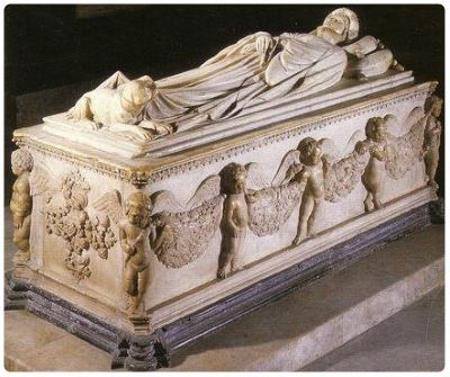 Ilaria was Paolo Guinigi's wife, perhaps at the time the
richest man in Europe. It was said she was beautiful,
well-educated and of good dowry. She ended up marrying the
Lord of Lucca for political reasons, but in reality was
loved by the Guinigi and by Lucca. She was only 26 years old
when she died in 1405, giving birth to a daughter, also
named Ilaria. Guinigi was a man of power and culture who
understood art and recognised its value. In order to express
his passion and power, he commissioned a tomb for his wife,
something which was uncommon in Italy. By placing the tomb
in an abnormal position, inside his hometown Cathedral, he
could forever remind Lucca of the Guinigi family’s power. A
seigneurial chapel was built in the transept of the Church.
The sculpture for Ilaria was built a few years after her
death, by Jacopo della Quercia; on the woman’s face no
suffering is apparent, yet nor is death represented; but
instead the depiction of a peaceful sleep. Instead of
showing you a picture of the monument, we recommend seeing
the marble sculpture in person; here is a picture of
Ilaria’s dog, however, which we will discuss below. Ilaria was Paolo Guinigi's wife, perhaps at the time the
richest man in Europe. It was said she was beautiful,
well-educated and of good dowry. She ended up marrying the
Lord of Lucca for political reasons, but in reality was
loved by the Guinigi and by Lucca. She was only 26 years old
when she died in 1405, giving birth to a daughter, also
named Ilaria. Guinigi was a man of power and culture who
understood art and recognised its value. In order to express
his passion and power, he commissioned a tomb for his wife,
something which was uncommon in Italy. By placing the tomb
in an abnormal position, inside his hometown Cathedral, he
could forever remind Lucca of the Guinigi family’s power. A
seigneurial chapel was built in the transept of the Church.
The sculpture for Ilaria was built a few years after her
death, by Jacopo della Quercia; on the woman’s face no
suffering is apparent, yet nor is death represented; but
instead the depiction of a peaceful sleep. Instead of
showing you a picture of the monument, we recommend seeing
the marble sculpture in person; here is a picture of
Ilaria’s dog, however, which we will discuss below.
The small dog at Ilaria’s feet
The small dog at the young woman’s feet seems to look at her,
pleading to be stroked; it does not accept the events, nor
can it interpret them. We have no way of knowing if the dog
ever existed. It seems to represent a symbol of marital
fidelity, as was the custom of the time. This was especially
the case in the courts of Northern Europe with which the
Tuscan Lordships were well connected. From an artistic point
of view, the position of the dog guides the viewer towards a
broader and deeper perspective of the woman's face.
Recent studies have established that Ilaria del Carretto was
never buried in this magnificent Tomb. Her mortal remains
were buried in the Church of Santa Lucia, in the complex of
San Francesco, Lucca. Central to these studies is the
Guinigi chapel, in which several members of this noble
Lucchese family were buried. Also in the Chapel, but
separated from the rest, are tombs which according to
studies contain the remains of Gionigi’s wives. He had four
wives: Mary Catherine of Anterminelli, the first young wife
(she was only 12 years old when he died in 1400 from the
plague), Ilaria del Carretto, Piacentina da Varano and
finally Jacopa Trinci, his last wife (she married in 1420
and died in 1422). One of these graves has a skeleton, aged
between 20 and 27 years old, which is attributed to Ilaria
del Carretto. Whether or not the body is that of Ilaria, the
memorial to her name remains a splendid work and is visited
every year by art lovers from all over the world.
We have the famous art critic John Ruskin to thank for the
fame that Ilaria’s monument has received internationally.
Ruskin repeatedly visited Lucca to visit his "Ilaria" and he
painted four watercolours of her. After his first sitting in
front of the sculpture he wrote:
"She sits on a pillow, with a dog at her feet. Her medieval
robes are quite modest, tight sleeves a closed neck, a wide
open neckline. The head is surrounded by a band of three
star-shaped flowers and her hair is styled in the manner of
Mary Magdalene, with a subtle curl that brushes her cheek.
Her arms are delicately set back gently on the body and her
hands come together in the act of praying. The soft draping
reaches her feet, almost hiding the dog".
From then onwards, Ilaria would always remain dear to the
great critic, a love affair that lasted almost a lifetime.
In fact 30 years later he wrote:
"I think back to my first sighting of the tomb of Ilaria del
Carretto and to how I knew, from that moment, that for me
she would become the supreme model."
+++
Curiosities
Is Ilaria’s nose damaged? According to popular tradition,
kissing the nose of the Ilaria sculpture brought fortune to
the young ladies who wanted to get married. This belief
continued over the centuries and gradually, in some kind of
"Lucchese suiseki" started to wear away the statues
beautiful nose. Don't try it nowadays as there is an alarm
fitted!
Copyright © Informagiovani-italia.com.
Up
Ostelli Lucca
Ostelli Italia
Auberges de Jeunesse
Italie Hotel
Lucca
Carte Lucques
Karte von Lucca
Mapa Lucca
Map of Lucca
Carte
de la Toscane
Karte von Toskana
Mapa Toscana
Map of Tuscany
Carte d'Italie
Karte von Italien
Mapa Italia
Map of Italy
|